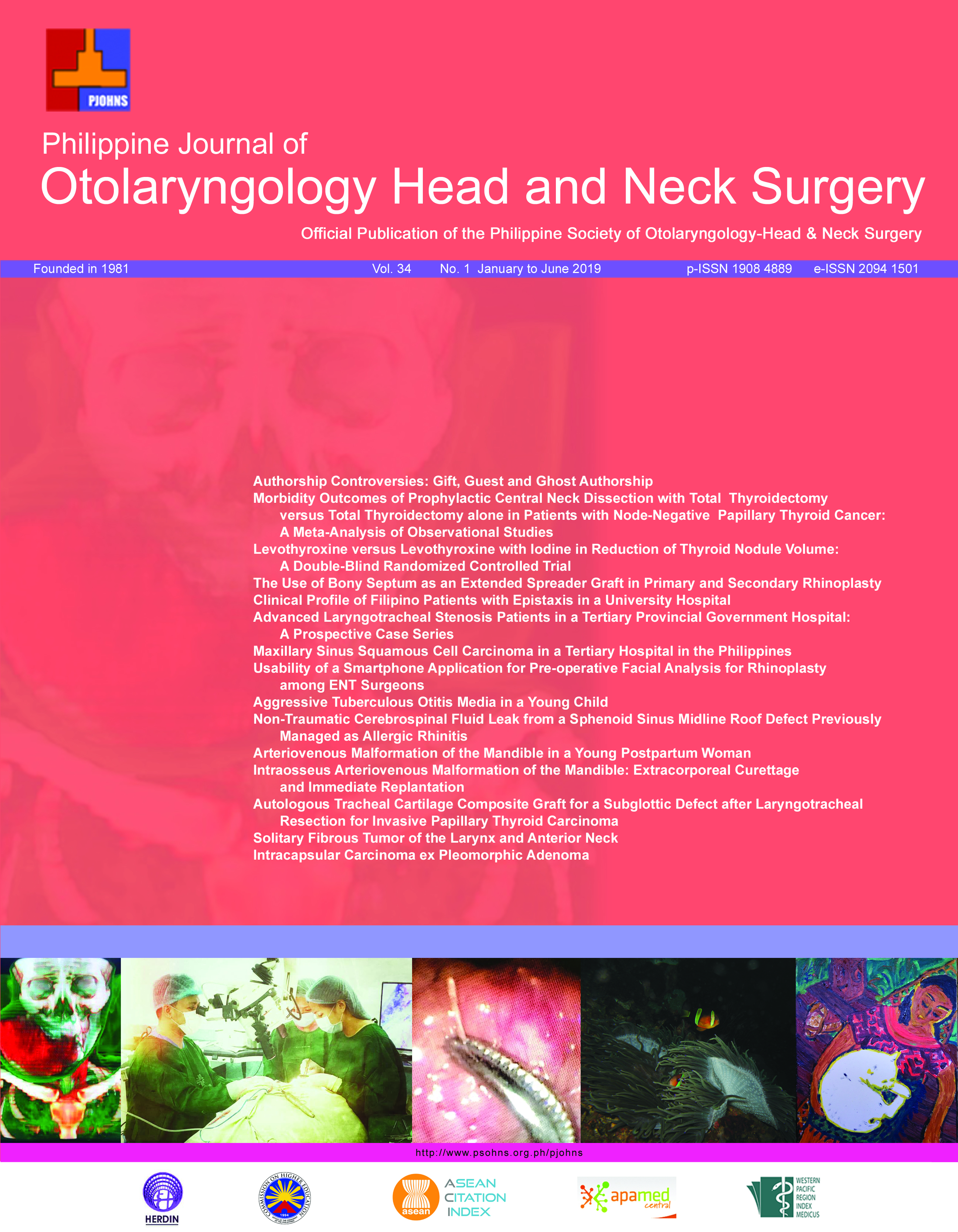Advanced Laryngotracheal Stenosis in a Tertiary Provincial Government Hospital: A Prospective Case Series
DOI:
https://doi.org/10.32412/pjohns.v34i1.135Keywords:
laryngotracheal stenosis, laryngotracheal reconstruction, tracheal resection anastomosis, subglottic stenosis, tracheal stenosisAbstract
Objective: To describe the clinical profiles, interventions, and surgical outcomes of patients with advanced (grade III and IV) laryngotracheal stenosis prospectively seen over a 2-year period.
Methods:
Design: Prospective Case Series
Setting: Tertiary Provincial Government Hospital
Participants: Five (5) patients with advanced laryngotracheal stenosis confirmed by laryngoscopy and/or tracheoscopy.
Results: Five (5) patients (4 males, 1 female), aged 23 to 31years (mean 27-years-old) diagnosed with advanced laryngotracheal stenosis between June 2016 to June 2018 were included in this series. Four resulted from prolonged intubation (14 - 60 days) while one had a prolonged tracheotomy (13 years). Presentations of stenosis included dyspnea on extubation attempt (n=3), failure to extubate (n=1) and failure to decannulate tracheotomy (n=1). Stenosis length was 3 cm in two, and 1.5 cm in three. Of the five (5) patients, three had grade IV stenosis while two had grade III stenosis based on the Cotton-Myer Classification System. Two of those with grade IV stenosis and both patients with grade III stenosis had undergone prolonged intubation. The stenosis involved the subglottis in three, and combined subglottic and tracheal stenosis in two. Prolonged intubation was present in all three with subglottic stenosis, and in one of the two with combined subglottic and tracheal stenosis. Two patients underwent open surgical approaches while three underwent endoscopic dilatation procedures. Four patients were successfully decannulated while one is still on tracheostomy. None of them had post-operative complications.
Conclusion: Advanced laryngotracheal stenosis is a challenging entity that results from heterogenous causes. Categorizing stenosis and measuring stenosis length may help in treatment planning and predicting surgical outcome.
Keywords: laryngotracheal stenosis; laryngotracheal reconstruction; tracheal resection anastomosis; subglottic stenosis; tracheal stenosis
Downloads
Published
How to Cite
Issue
Section
License
Copyright transfer (all authors; where the work is not protected by a copyright act e.g. US federal employment at the time of manuscript preparation, and there is no copyright of which ownership can be transferred, a separate statement is hereby submitted by each concerned author). In consideration of the action taken by the Philippine Journal of Otolaryngology Head and Neck Surgery in reviewing and editing this manuscript, I hereby assign, transfer and convey all rights, title and interest in the work, including copyright ownership, to the Philippine Society of Otolaryngology Head and Neck Surgery, Inc. (PSOHNS) in the event that this work is published by the PSOHNS. In making this assignment of ownership, I understand that all accepted manuscripts become the permanent property of the PSOHNS and may not be published elsewhere without written permission from the PSOHNS unless shared under the terms of a Creative Commons Attribution-NonCommercial-NoDerivatives 4.0 International (CC BY-NC-ND 4.0) license.



